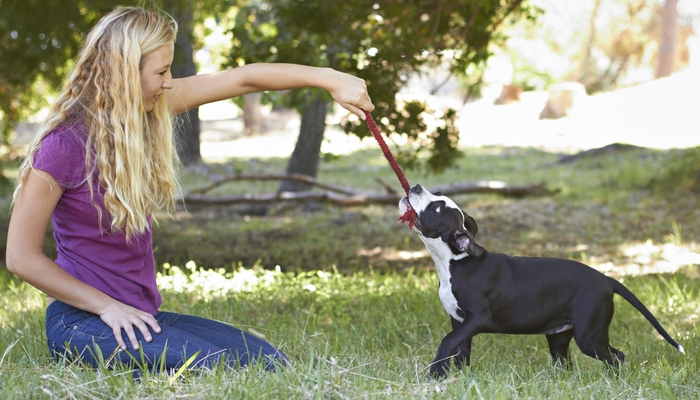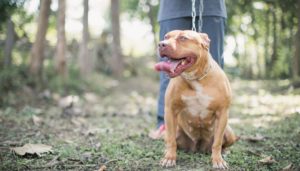If you ask some dog trainers, dog breeders, veterinarians and other dog experts to name one dog breed that's the most misunderstood, most of them will name the Pit Bull.
This breed's history is the most shrouded in myths and incomprehension. That's why we're setting the record straight with these Pit Bull facts.
Even the name Pit Bull is somewhat of a misunderstanding since it isn't actually a breed in and of itself.
It's just a generic term that's used to describe dogs with similar traits and characteristics, including the American Pit Bull Terrier (or APBT, which is what people usually call a “Pit Bull”), American Staffordshire Terriers, and a lot of other Pit mixes.
APBT is a breed that's associated with aggression towards dogs and people alike.
It's a breed that's viewed as nearly impossible to train and as a breed that's owned by people who want an aggressive dog.
To break truth from myth, here I've compiled a quick list of 23 Pit Bull facts, interesting tidbits and other information dog lovers or future adopters may want to know about the APBT breed and about “Pit Bulls” in general.
I hope this list will help you and the Pit-Bull owners-to-be to understand this wonderful breed better and have a great time raising and living with these amazing dogs.
23 Pit Bull Facts
and why you should adopt one
 1. The American Pit Bull Terrier is a “family dog” and a “companion dog” breed
1. The American Pit Bull Terrier is a “family dog” and a “companion dog” breed
It was originally bred to bait and herd bulls, which is where the “bull” part of its name comes from. However, they later evolved into all-around farm dogs.
There's also a myth out there that sometime later, they became in-house dogs or “nanny dogs”, due to their inherent love for people and high intelligence; however, that's not true.
2. There are multiple breeds under the Pit Bull umbrella
The dog breeds that are typically associated with the name “Pit Bull” are:
- American Pit Bull Terrier
- America Staffordshire Terriers
- Bull Terrier
- Dogo Argentino
- Japenese Tosa
- Dogue de Bordeaux
- Bulldog
For short, in this article we'll address all of them as just Pit Bulls or we'll talk specifically about the APBT (American Pit Bull Terrier).
3. They were used to fight in pits
The “pit” part of the APBTs name, as well as most of the myths surrounding the breed, come from the fact that many APBTs were bred to fight in pits.
Several centuries ago, many dog owners and dog breeders recognized the inherent playfulness, intelligence, and obedience that the breed possesses and understood how easy it would be to train them to fight other dogs in dog pits.
4. Aggression is an inherent part of the Pit Bull breeds
 We won't try to sugar coat any Pit Bull facts linked to aggression.
We won't try to sugar coat any Pit Bull facts linked to aggression.
The American Pit Bull Terrier, as well as most other “Pit Bull” breeds were bred for several centuries to fight other dogs.
This is an inescapable fact, as much as the fact that Labradors love to “retrieve” things”, that Salukis and other sight hounds like to chase things, that Beagles and other scent hounds love to follow smells, etc.
It's just what these dogs were bred for.
5. “Dog aggression” and “Human aggression” are two completely different things
Despite that fact that a lot of modern Pit bull owners intentionally or unintentionally train their dogs to be aggressive towards people, “human aggression” is not inherent to the APBT breed. Far from it, in fact.
The APBT and other Pit Bulls are extremely people-loving dogs.
To understand this, we must first understand the science behind dog aggression, but generally, Pits are typical companion and family dog breeds.
Pit bulls may have been bred to fight other dogs in pits, but they were trained to obey their owners – and they are happy to do so.
6. Human aggression is foreign for a Pit Bull
This is one of the Pit Bull facts that many people do not realize.
While as pit dogs they were trained to fight other dogs, they were also trained to be mindful, respectful and loving towards people.
After all, their owners were usually inside the pit with them.
7. They are not easy to train
 The fact that they are people-loving and intelligent dogs doesn't make them easy to raise and train.
The fact that they are people-loving and intelligent dogs doesn't make them easy to raise and train.
As we said above, the simple fact is that Pit Bulls were bred to fight.
Even a well-trained and well-raised APBT can sometimes spring into a dog fight, seemingly unprovoked.
This is just a part of their instinct. Pit Bulls require a lot of experience, knowledge and patience from their owner in order to become the dogs that they could be and not get into any trouble.
If you haven't owned a dog and you want to get one for your child – we wouldn't recommend a Pit Bull.
RELATED: 13 Banned Dog Breeds (and tips to prevent aggressive behavior)
8. You need to understand the history of the Pit Bull
There are some Pit Bull facts you need to know in order to work with these dogs effectively.
To properly train a Pit Bull, one must understand the breeds' dog-fighting history and instincts.
When we say that, we don't mean that you should train your Pit Bull to fight and be aggressive – far from it.
We simply mean that you have to understand these breeds' instinct to fight, to acknowledge it, in order to properly train the dog around it.
Yes, the myth about the aggression of Pit Bulls is overly perpetuated.
However, it is not unfounded. Understand how your Pit Bull thinks, and only then will you be able to raise and train him properly.
9. Fighting instincts aren't always obvious
 The “fighting” instinct of Pit Bull breeds today doesn't necessarily display in an aggressive behavior.
The “fighting” instinct of Pit Bull breeds today doesn't necessarily display in an aggressive behavior.
What do we mean by that?
This means that while APBTs and other Pit Bulls do have the instinct and the “urge” sometimes to fight other dogs, they don't do it out of aggression. They simply do it out of instinct.
It is very common for two Pit Bulls to live together for years and to love each other, but to once spring into combat, to fight fiercely with each other, and when broken off, to continue living together peacefully, to play with each other, to eat from the same bowl, etc.
To fight other dogs is an instinct for these dogs, and it's one of the Pit Bull facts you need to know.
Fighting may not be something that Pit Bulls do out of aggression or malice.
10. The Pit Bull can be one of the most loving and affectionate breeds
When raised and handled properly, Pit Bulls are some of the most loving, obedient, playful, and gentle dog breeds out there.
In fact, the American Temperament Test Society rates the American Pit Bull Terrier at 82.3% in terms of their temperament and obedience – a percentage that places the breed as one of the top 5 most stable breeds of dogs in the United States.
11. Pit Bulls see themselves as lap dogs
They are playful dogs, don't get us wrong – a Pit Bull requires a lot of exercise and playtime, however, once they are done with that, they love to snuggle and to get belly rubs more than anything in the world.
A Pit bull loves and craves for your attention, which is why they were so easily trained a pit dogs in the first place.
It will love to sleep with you and to snuggle with you at any time when not playing.
If you want a gentle and lovable companion dog, then as long as you're willing to put in the work, a Pit Bull can be the dog for you.
12. They fight silently
 When they are in a fight, APBTs and other Pit Bulls fight almost without making a noise. Usually, they won't even bark or growl – they will just jump at each other and fight into a bloody mess, until they are broken apart.
When they are in a fight, APBTs and other Pit Bulls fight almost without making a noise. Usually, they won't even bark or growl – they will just jump at each other and fight into a bloody mess, until they are broken apart.
This is even more evidence that Pit Bulls fight out of instinct and not out of aggression – barking and growling are signs of aggression, and they are usually absent in a Pit Bull fight.
We mention this in our list of Pit Bull facts because you should always keep an eye on these dogs when they're together with another dog.
Regardless of how well-trained and well-mannered he is, it's better to be safe than sorry.
13. They aren't as submissive as other breeds
Pit Bulls lack a lot of the “submission behaviors” that other dog breeds have.
This means that most dog breeds instinctively know certain behaviors that lack aggression – rolling over and showing their belly, for example.
Pit Bulls sometimes can't/don't do this instinctively (and need to be trained to do it).
Often they don't recognize or acknowledge this in other dogs either.
As a result, if a Pit Bull decides that it's time to fight, it will fight even if the other dog is showing submission.
Dog breeders have intentionally bred this out of Pit Bulls, so they don't stop fighting in the pit.
ALSO READ: Top 15 World's Deadliest Dog Breeds
14. They can be quite purposeful and head-fast.
 What this means is that they don't just love to play, but they love to get deep into trouble.
What this means is that they don't just love to play, but they love to get deep into trouble.
If a Pit Bull decides to destroy your couch while you are at work (a decision that won't be shared with you until the deed is done), it will do so, and it will do so thoroughly.
This is part of why Pit Bulls can be hard to train. As with other intelligent breeds, Pit Bulls respond well to training, but they are also very imaginative.
One of the Pit Bull facts that most people don't realize is that you need to train them very well.
On the upside, if these dogs decide to snuggle you and shower you with kisses, they will also do so extremely thoroughly.
15. These dogs have a mixed heritage
One of the Pit Bull facts that may be surprising to you is that these dogs are quite mixed in breed.
Unless you have the full pedigree of your dog, you can't be certain of its history.
This is why most people will tell you to never get a Pit Bull from a shelter or a rescue, and to never get a Pit Bull if you can't be certain about its parentage and origins.
This advice is not without merit, as some terrier and Pit Bull breeds have almost nothing in common with the pit-fighting dogs they are associated with, while others come straight from them.
Additionally, a lot of Pit Bulls and APBTs from shelters come from heavily abused parents or were heavily abused themselves.
The sad reality is that even today a lot of owners get a Pit Bull specifically to train them to fight.
It is always a good idea to know what your Pit Bull's origins are.
On the flip side, most high-profile shelters do extensive behavior-evaluations to their dogs before they put them for adoption, so if you are getting a Pit Bull from such a shelter, you can rest assured that you're being given a good, well-behaved dog.
If you are worried, it is always a good idea to consult with a professional dog trainer / breeder upon adopting.
16. It's safe to adopt a Pit Bull of any age
It is a myth that you should never get a grown Pit Bull, and instead adopt Pit Bull puppies only.
The fact of the matter is that whether your Pit Bull is dominant or submissive is determined almost entirely by its history.
Whether you get your dog young or old, this is a trait that will still be there.
Furthermore, with an adult dog you'll be able to see (or ask) whether the dog is dominant or submissive, while with a puppy you'd need a full family history to get an idea.
This isn't to say that you shouldn't avoid Pit Bull puppies.
They are adorable, and they offer an almost blank slate for your training.
Just don't avoid adopting a grown Pit Bull based entirely on this myth.
17. They aren't just trained to fight other dogs
 This is one of the most scary Pit Bull facts on this list.
This is one of the most scary Pit Bull facts on this list.
In their “pit days” these dogs weren't trained to fight other dogs exclusively.
In fact, people managed to come up with a lot of different and bloody animal sports. For example:
- In the early days of pit fighting, even before they were taken to America, Pit Bulls were trained to bear bait. This was a bloody sport in which bears were publicly tortured by both people and dogs, for the entertainment of onlookers.
- Another such bloody sport became popular after bear baiting was banned in England – ratting. In ratting, a pit was filled with rats and several dogs competed to see who could kill more rats in the shortest amount of time.
18. Pit Bulls are notorious fence climbers
Being very athletic dogs, most Pit Bull breeds are exceptional escape artists, so keep this in mind if you intend to leave them alone in a yard, even if it is well-fenced.
In fact, just don't leave them alone in a yard – they are indoor dogs anyway.
Don't believe us? It's okay, we understand. This is one of the most hard to believe Pit Bull facts.
Take a look at this Pit Bull climbing a 12-foot fence. It took it several tries, yes, but as we said, these dogs are very driven and stubborn animals, once they set their mind to something.
19. They are NOT good guard dogs
Pit Bulls are not good guard dogs, despite their false reputation and even though a lot of people get them for that very purpose.
Pit Bulls are too people-loving to be good guard dogs.
They would need to be specifically trained to be aggressive towards humans (something which we do not condone). Even then, their human-loving instincts may prevail.
20. Some types of Pit Bulls are more popular than others
Razor Edge Pit Bulls and Blue Nose Pit Bulls are two types of Pit Bulls that are very sought-after.
Razor Edges have a very bulky appearance and an even gentler than usual nature, while Blue Nose Pit Bulls have a very distinctive blue/gray coloration.
Both types can be very expensive and sell for thousands of dollars. However, neither is an actual separate breed – both are just variations of the different standard Pit Bull breeds.
21. Pit Bulls do NOT have locking jaws
 This is probably one of the Pit Bull facts that is most commonly misconceived. That's been continuously perpetuated by pop-culture and the media. Pit Bull jaws are quite the same as the jaws of any other dog breed.
This is probably one of the Pit Bull facts that is most commonly misconceived. That's been continuously perpetuated by pop-culture and the media. Pit Bull jaws are quite the same as the jaws of any other dog breed.
Pit Bulls are just very strong and muscular, making their bite very strong. Since they are also quite driven and stubborn dogs, Pit Bulls can oftentimes bite hard on something and not let go.
22. The most decorated dog in WWI was a Pit Bull
Sergeant Stubby is the most decorated dog in the First World War and it was a Pit Bull.
And no, Sergeant Stubby didn't fight in the war – instead, it helped comfort the wounded soldiers in the infirmary.
Stubby saw 17 battles on the Western Front and cuddled with, kissed, loved, and comforted thousands of soldiers – this is a “typical” Pit Bull behavior.
23. The perception of Pit Bulls has drastically changed
A century ago, Pit Bulls were known as “America's dog”, making countless of appearances in advertisements and posters.
Today they are America's most abused dogs.
Because abusive and aggressive owners mostly adopt them, Pit Bulls often find themselves:
- tortured
- chained outside the house when they haven't acted aggressively enough for their owner's desires
- neglected by people who just wanted a guard dog.
If one type of dog deserves and needs to be more frequently adopted by proper and loving dog owners, it's the Pit Bull breeds.
I bet this is one of the Pit Bull facts you weren't expecting to see on this list.
Adopting a Pit Bull: Why These 23 Facts Will Make You Fall in Love with the Breed and Want to Give Them a Forever Home
And there you have them – our 25 Pit Bull facts. If we had to quickly summarize them all, it would look like this:
Pit Bulls are exceptionally loving, gentle, playful and intelligent dogs that love their families and people as a whole. They've had a very difficult history and as a result have picked up a couple of bad habits that they need to be trained out of.
Pit Bulls may be a challenge to train, but when they are raised and trained properly, they are the best possible companions a dog owner can wish for. Give them a chance.
Related Articles:
- Vet's Tips On How To Raise A Pit Bull Puppy Healthily
- 5 Most Common Dog Breed Stereotypes DEBUNKED
- Pit Bull Muscle Gaining 101: How to Bulk Up a Pit Bull Healthfully
Want To Share?













